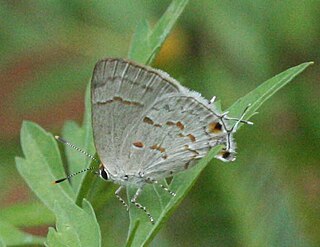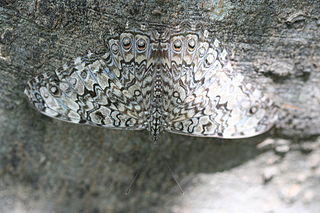
Emily Burns Strayer is an American songwriter, singer, multi-instrumentalist, and a founding member of the country band The Chicks, formerly known as the Dixie Chicks. Strayer plays banjo, dobro, guitar, lap steel, bass, mandolin, accordion, and sitar. Initially in her career with The Chicks, she limited her singing to harmony with backing vocals, but within her role in the Court Yard Hounds, she has taken on the role of lead vocalist.

Marpesia petreus, the ruddy daggerwing, is a species of butterfly of the family Nymphalidae. It is found in Brazil north through Central America, Mexico, and the West Indies to southern Florida. Strays are found as far north as Arizona, Colorado, Nebraska, Kansas, and southern Texas.

Achalarus toxeus, the coyote cloudywing or coyote skipper, is a butterfly of the family Hesperiidae. It is found from Panama, north through Central America and Mexico to central Texas. Strays can be found up to southern Arizona.

Achlyodes mithridates, the sickle-winged skipper or Jung's dusky wing, is a butterfly of the family Hesperiidae. It is found from Argentina, north through tropical America and the West Indies to southern Texas. A regular stray north to central Texas, rarely to Arkansas and Kansas.

Pyrgus philetas, the desert checkered skipper, is a species of skipper butterfly. It is found in North America from southern Arizona east to southern Texas, south to southern Mexico. Strays are found north to northern Arizona and northern Texas.

Anthanassa frisia, the Cuban crescentspot, Cuban checkerspot or Cuban crescent, is a butterfly of the family Nymphalidae. Subspecies tulcis is known by the common names pale-banded crescent or Tulcis crescent; it is treated as a species by some authors. The nominate subspecies is found in the West Indies and southern Florida, with strays to northern Florida. Subspecies tulcis is found from Argentina north through Central America and Mexico to southern Texas, strays to west Texas and southern Arizona. Other subspecies are resident to South America.

Astraptes anaphus, the yellow-tipped flasher or dull astraptes, is a species of butterfly of the family Hesperiidae. It is found from Argentina, north through Central America to the West Indies and Mexico. Strays can be found up to the lower Rio Grande Valley in Texas.

Erynnis funeralis, the funereal duskywing, is a butterfly of the family Hesperiidae. It is found from southern California, Arizona, New Mexico and Texas, south to Argentina and Chile. Strays can be found north up to northern Illinois, north-eastern Nebraska, central Colorado, southern Nevada and central California.

Calpodes ethlius, the Brazilian skipper, larger canna leafroller or canna skipper, is a butterfly of the family Hesperiidae. It is found in the United States from southern Florida and southern Texas, south through the West Indies, Mexico, and Central America to Argentina. Strays and temporary colonies can be found north to southern Nevada, northern Texas, Illinois and Massachusetts.

Wallengrenia otho, the southern broken dash or broken dash skipper, is a butterfly of the family Hesperiidae. It was originally described by Smith in 1797. It is found from eastern Texas and the southeastern United States, south through the West Indies and Central America to Argentina. Strays can be found as far north as central Missouri, northern Kentucky and Delaware.

Urbanus dorantes, the lilac-banded longtail or Dorantes longtail, is a butterfly of the family Hesperiidae. It is found from Argentina, north through Central America, Mexico, and the West Indies to southern Texas and peninsular Florida. Strays can be found as far north as northern California, southern Arizona, southern Missouri and North Carolina.

Urbanus procne, the brown longtail, is a butterfly of the family Hesperiidae. It is found from Argentina, north through Central America and Mexico to southern Texas. Rare strays can be found up to southern New Mexico, southern Arizona and southern California.

Chiomara asychis, the white-patched skipper or white patch, is a butterfly of the family Hesperiidae. It is found from Argentina, north through tropical America to the West Indies and southern Texas. Strays can be found as far north as southern Arizona, Nevada and Kansas.

Celotes nessus, the common streaky-skipper, is a butterfly of the family Hesperiidae. It is found in North America from southern Arizona, southern New Mexico, and western Texas south to northern Mexico. Rare strays can be found up to southern Oklahoma and northern Louisiana.

Tmolus echion, the red-spotted hairstreak or larger lantana butterfly, is a butterfly in the family Lycaenidae. It is found from Brazil, north to Sinaloa and Tamaulipas in Mexico. Rare strays can be found in southern Texas. It was introduced to Hawaii in 1902 to control lantana.

Pyrisitia nise, the mimosa yellow, is a butterfly in the family Pieridae. It is found from Argentina north to the Texas Gulf Coast and throughout central and southern Florida, northward to the Tennessee Valley. It is an occasional stray to central Texas and south-eastern Arizona and rarely to southern California, southern Colorado and Kansas. The habitat consists of brushy woodland edges.

Phoebis agarithe, the large orange sulphur, is a butterfly in the family Pieridae. It is found from Peru north to southern Texas and peninsular Florida. Rare strays can be found up to Colorado, South Dakota, Wisconsin, and New Jersey. The species has also been introduced in Hawaii. The habitat consists of open, tropical lowlands including gardens, pastures, road edges, trails and parks.

Hamadryas februa, the graycracker, is a species of cracker butterfly in the family Nymphalidae. It is found from Argentina north through tropical America to Mexico. Rare strays can be found up to the lower Rio Grande Valley in southern Texas. The habitat consists of subtropical forests, forest edges and cultivated areas with trees.

Rekoa marius, the Marius hairstreak, is a butterfly in the family Lycaenidae. It is found from Paraguay north to Sonora in Mexico. Strays may be found as far north as southern Texas. The habitat consists of disturbed tropical areas.



















